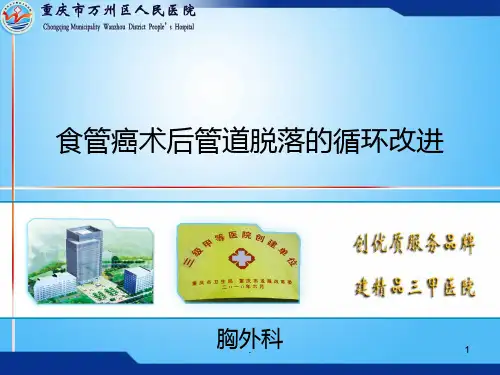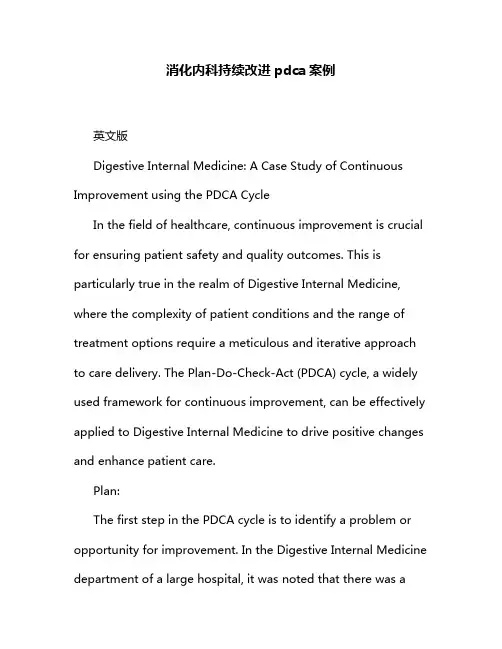消化内科pdca案例ppt
- 格式:pptx
- 大小:18.64 MB
- 文档页数:66








消化内科持续改进pdca案例英文版Digestive Internal Medicine: A Case Study of Continuous Improvement using the PDCA CycleIn the field of healthcare, continuous improvement is crucial for ensuring patient safety and quality outcomes. This is particularly true in the realm of Digestive Internal Medicine, where the complexity of patient conditions and the range of treatment options require a meticulous and iterative approach to care delivery. The Plan-Do-Check-Act (PDCA) cycle, a widely used framework for continuous improvement, can be effectively applied to Digestive Internal Medicine to drive positive changes and enhance patient care.Plan:The first step in the PDCA cycle is to identify a problem or opportunity for improvement. In the Digestive Internal Medicine department of a large hospital, it was noted that there was ahigher than expected readmission rate for patients with Gastroesophageal Reflux Disease (GERD). The team hypothesized that this could be due to a lack of standardized discharge instructions and follow-up plans.Based on this, the team formulated a plan to create a standardized discharge protocol for GERD patients, including clear instructions on lifestyle modifications, medication adherence, and follow-up appointments. They also planned to train the staff on this new protocol to ensure its effective implementation.Do:The team implemented the plan by rolling out the new discharge protocol for GERD patients. They conducted training sessions for the staff, emphasizing the importance of adhering to the protocol and its impact on patient outcomes. Additionally, they ensured that the protocol was easily accessible to all staff members.Check:After implementing the new protocol, the team monitored the readmission rate for GERD patients. They found that while there was a slight improvement, the results were not as significant as expected. Upon further analysis, they realized that some staff members were not fully adhering to the protocol, and there was a lack of consistent follow-up with patients.Act:In response to these findings, the team took corrective actions. They reinforced the training on the discharge protocol and conducted regular audits to ensure compliance. They also introduced a reminder system to ensure consistent follow-up with patients. Additionally, they encouraged staff members to provide feedback on the protocol, which helped identify further areas for improvement.Conclusion:By applying the PDCA cycle, the Digestive Internal Medicine department was able to identify and address issues related to patient readmissions for GERD. While the initial implementationdid not yield significant results, the team's responsive actions and continuous improvement mindset allowed them to refine the process and achieve better outcomes. This case study demonstrates the effectiveness of the PDCA cycle in driving positive changes in healthcare delivery and enhancing patient care.中文版消化内科:使用PDCA循环持续改进的案例研究在医疗领域,持续改进对于确保患者安全和提高治疗效果至关重要。

